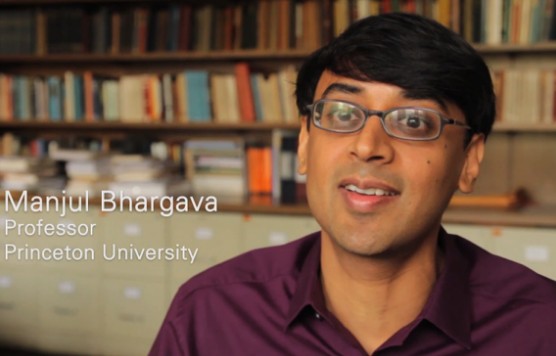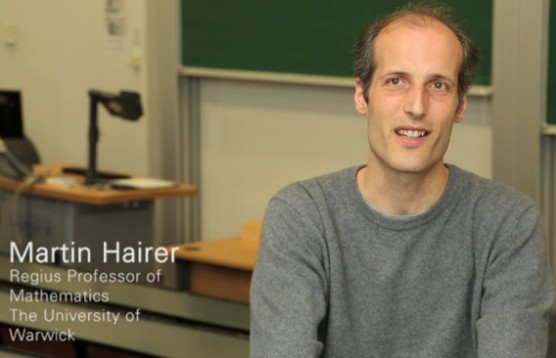博文
2014首位女菲尔兹奖得主诞生:伊朗裔女数学家Maryam Mirzakhani
 精选
精选
||
陶哲轩确实很厉害。每次菲尔兹奖出来,他都要讨论一下每个得奖人的代表性工作。现在的数学发展,差不多到了隔行如隔山的地步,搞代数不懂分析,搞微分方程的不懂数论,等等。但陶哲轩竟然能把不同得奖人的工作讲得头头是道,不愧是全能数学家。这是他对今年四位得奖人的工作的介绍https://terrytao.wordpress.com/tag/martin-hairer/
“国际数学家大会”(International Congress of Mathematicians)12日宣布,伊朗出生的米尔札哈尼获颁数学界最高荣誉“费尔兹奖”(http://en.wikipedia.org/wiki/Fields_Medal),她是该奖首位女性得主,也是伊朗第一个获得此殊荣的人。这个奖每四年一次颁发给至多四个在该年初不到40岁的人。自1936年以来的所有52名获奖者均为男性。国际数学家大会发布的声明说:“她熟练多种数学技巧有很高的数学修养,很难得地集超强的技术能力、大无畏的雄心、远大的眼光和无穷的好奇心于一身。”

ICM官方网站http://www.icm2014.org/
费尔兹奖1936年开始颁发,每4年颁给2到4位年龄不满40岁的得主。国际数学家大会12日在韩国首尔的会议上宣布“费尔兹奖”4位得主,得奖者之一米尔札哈尼(Maryam Mirzakhani)毕业于美国哈佛大学,目前在加州斯坦福大学任教。斯坦福新闻http://news.stanford.edu/news/2014/august/fields-medal-mirzakhani-081214.html。她做的是几何和动态系统相关的工作。成果可以应用到量子场论中。
Maryam Mirzakhani(1977-)伊朗女数学家,斯坦福教授,两届IMO金牌,Clay研究奖。1977年出生于伊朗首都德黑兰,在伊朗完成大学学业后到哈佛深造,2004年取得哈佛博士学位。工作领域为遍历理论、代数几何和双曲几何。重证Witten猜想,最近工作重心在Teichmueller测地流“我喜欢学习数学的不同领域并理解他们之间的**。她 2009年获颁布鲁门塔奖(Blumenthal Award forthe Advancement of Research in Pure Mathematics),2013年又获美国数学学会(American Mathematical Society)颁发的沙特奖(Satter Prize)肯定。
Mirzakhani研究模空间几何。那是一种复杂的几何和代数的实体,可以被描述为一个每一点本身都是一个宇宙的宇宙。Mirzakhani描述了一束光沿一个闭圈在二维宇宙中行走的方法数。事实上,要回答这个问题,你不能仅仅待在你“原来的”宇宙中—你必须知道如何在整个多重宇宙里航行。Mirzakhani给数学家们展示了在这些空间里航行的新方法。
Mirzakhani在1995时作为高中生第一次吸引了国际范围的关注,那时她是第一位在IMO获得满分的伊朗学生。
“她在伊朗非常非常著名,在那里她成为了年轻一代学生的榜样“,国际数学联盟的主席Ingrid Daubechies说。国际数学联盟是选择菲尔兹奖的机构。
”我自己作为一名女性,对她能获奖感到非常高兴“,Ingrid Daubechies又说,”这改变了经常被引用的‘女性从未获奖’的事实。“在将来,她说,女性获得顶尖的数学奖将不会再显得特殊。

Maryam Mirzakhani的维基百科http://en.wikipedia.org/wiki/Maryam_Mirzakhani

Maryam Mirzakhani的数学谱系计划(Mathematics Genealogy Project)
http://www.genealogy.math.ndsu.nodak.edu/id.php?id=91093
其他三位获奖者还有:
来自Instituto Nacional de Matemática Pura e Aplicada 和 CNRS的巴西-法国数学家Artur Avila(1979-)

Avila 1979年出生于巴西,16岁拿IMO金牌,19岁就写了第一篇paper,22岁赴法国学院读博士后,完全是少年天才的标准履历。Avila主要做的是动力系统方向,他在这个方向上做出许多原创性的成果,因而获得了法国科学学院颁发的Grand Prix Jacques Herbrand,这个奖项主要鼓励35岁以下的青年数学家,(03年Werner也拿过这个奖,06年就拿fields了),现在Avila在Clay数学所工作。
【维基百科简介http://en.wikipedia.org/wiki/Artur_Avila】, 研究方向是动力系统和谱理论。
来自Princeton University加拿大-美国Manjul Bhargava(1974-)

1974年出生的Manjul Bhargava在美国长大,算是神童吧。母亲教数学,父亲教化学。他14岁读完高中所有课程;1996年哈佛大学数学系毕业,2001年普林斯顿数学博士,导师就是解决费马大定理的那位永远记入历史史册的Andrew Wiles. Manjul Bhargava在普林斯顿高等研究院做了两年访问学者,然后被普林斯顿大学数学系直接聘为正教授。据说这是常青藤大学里博士毕业到正教授时间最短的记录,也是普林斯顿大学历史上第2年轻的正教授,这段几乎可望不可及的路程Manjul Bhargava仅用了两年。
2012年加瓦对于数学家Manjul Bhargava来说,是收获的一年,数年的刻苦努力,终于取得成果。 2012年早些时候,美国普林斯顿大学数学系教授Manjul Bhargava 解决了代数数论椭圆曲线难题,因而备受追捧。 38岁的Manjul Bhargava今年赢得了今年的印孚瑟斯奖。他现在正致力于研究Birch and Swinnerton-Dyer猜想, 这是克雷数学研究所千禧年七大百万美元悬赏之一。
【维基百科简介http://en.wikipedia.org/wiki/Manjul_Bhargava】,研究方向是数论。
来自University of Warwick的英国数学家Martin Hairer(1975-)

Martin Hairer,奥地利人,现居英国,任职于华威大学。由于马丁在随机偏微分方程理论方面的杰出贡献,尤其是为这些方程建立了一套正则性结构理论,而被授予菲尔兹奖。他通过将新的想法,他做了许多重要方向的根本进步,如Hormander定理的变体的研究,随机系统的Lyapunov函数的对称构造,遍历的非马尔可夫系统的一般理论的发展,多尺度分析技术,均质化理论,样本轨道理论,最近的包括粗糙样本轨道理论和新引进的正则结构理论。
PS:Martin Hairer的太太是华人Xue-Mei Li
【维基百科简介http://en.wikipedia.org/wiki/Martin_Hairer】,方向是随机分析,特别是随机偏微分方程。
ICM官方网站介绍4位获奖者(英文)http://www.icm2014.org/en/awards/prizes/FieldsMedalist
| ||||
| ||||
| | ||||
| ||||
| | ||||
| ||||
| | ||||
| ||||
| | ||||
|
| ||||
| ||||
| ||||
|
| ||||
A mathematical problem that is important throughout science is to understand the influence of noise on differential equations, and on the long time behavior of the solutions. This problem was solved for ordinary differential equations by Itó in the 1940s. For partial differential equations, a comprehensive theory has proved to be more elusive, and only particular cases (linear equations, tame nonlinearities, etc.) had been treated satisfactorily. Hairer’s work addresses two central aspects of the theory. Together with Mattingly he employed the Malliavin calculus along with new methods to establish the ergodicity of the two-dimensional stochastic Navier-Stokes equation. Building on the rough-path approach of Lyons for stochastic ordinary differential equations, Hairer then created an abstract theory of regularity structures for stochastic partial differential equations (SPDEs). This allows Taylor-like expansions around any point in space and time. The new theory allowed him to construct systematically solutions to singular non-linear SPDEs as fixed points of a renormalization procedure. Hairer was thus able to give, for the first time, a rigorous intrinsic meaning to many SPDEs arising in physics. |
| ||||
| ||||
| ||||
| ||||
| ||||
|
这次50%的菲尔兹奖得主曾是普林斯顿高等研究院的成员
Manjul Bhargava于2001-2002年
Martin Hairer于2014年
另外此次国际数学家大会产生的其它奖得主有
奈望林纳奖
Subash Khot
高斯奖
Stanley Osher
陈省身奖
Phillip Griffiths
丽罗娃蒂奖
Adrián Paenza
https://m.sciencenet.cn/blog-752541-819205.html
上一篇:2014新增数学,统计和概率论SCI期刊汇总-附2014年SCI期刊影响因子
下一篇:出生在哈尔滨的著名统计学家Samuel Kotz(RSS,IMS&ASA三料Fellow)



